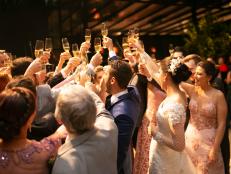22 Historic Venues That Will Take Your Wedding Back in Time
Say "I do" in classic style.
See Inside These Iconic Venues
You know the saying: Something old, something new, something borrowed, something blue. While brides are supposed to wear all of the aforementioned objects, traditions are allowed to be modified. Instead of wearing an antique, spring for celebrating in an old venue instead. From locations in Plymouth, Massachusetts to Los Angeles, California, here are some of the most gorgeous historic wedding venues across the United States.
NY Public Library
New York, New York
There’s a reason why Carrie Bradshaw wanted to say “I do” at New York Public Library’s Stephen A. Schwarzman Building. The gorgeous Midtown Manhattan structure is an incredibly important New York City landmark and research facility that, among other important onsite divisions, houses 800 rare books printed before the start of the 16th century. The place is absolutely beautiful with its ornate marble facade, iconic steps and pair of stone lions that flank the Fifth Avenue entryway – talk about making an entrance. The grandeur of the Beaux-Arts style building continues into the interior of rooms like the Celeste Bartos Forum, a vast space that can hold up to 500 guests under its 30-foot-high glass saucer ceiling that is just about as monumental as it gets.
Los Angeles Union Station
Los Angeles, California
Known as the "Last of the Great Railway Stations" built in the United States, this stunning 1939 transit hub combines Art Deco, Mission Revival and Streamline Moderne architectural styles for a jaw-dropping effect. The result is absolutely fabulous, representing the City of Angels on a grand scale. John and Donald Parkinson, two of the architects on the team, also designed Los Angeles’ City Hall and other local landmarks. To this day, the LA station is the largest and busiest in the western United States. Couples can choose to kick off their life journey together in spectacular spaces throughout the property, including the tree-lined South Patio and the historic Waiting Area. Guests will enjoy dancing atop inlaid stone floors and below soaring beamed ceilings with handpainted tiles and six Art Deco-inspired brass chandeliers that weigh more than 3,000 pounds each.
Marigny Opera House
New Orleans, Louisiana
Architect Theodore Giraud designed this 1853 building for the German Catholics of Faubourg Marigny. The Baroque church was known as Holy Trinity Catholic Church until the parish was relocated in 1997. A few years later, Scott King and Dave Hurlbert purchased the historic building and transformed it into a church of the arts where local performers showcase ballet, chamber music, jazz, theater and more. The gorgeous setting and creative vibe have been a magnet for celeb couples who want to tie-the-knot in a meaningful place. It’s where singer Solange Knowles and director Alan Ferguson held their all-white wedding. And, in addition to the venue being gorgeous, ceremonies held here help Marigny Opera House fund its mission to support local performance artists.
Arvest Bank Theatre at The Midland
Kansas City, Missouri
When the Midland was completed in 1927, the $4 million structure was the largest theater within 250 miles of the city. One look and you’ll know it was important. Architect Thomas W. Lamb of New York and the Boller Brothers of Kansas City designed the space with a few different styles. The Renaissance Revival cream-colored exterior features engaged pilasters, an array of figures and a four-story arched window that rises above the copper marquee. It’s eye-catching from the outside, and the inside is pure Gilded Age decadence. The French and Italian Baroque space boasts over 500,000 feet of gold leaf, five humongous Czechoslovakian hand-cut crystal chandeliers, one-of-a-kind objects d’art and intricate woodwork that’s so gorgeous you don’t even have to think about adding a thing for the wedding.
George Peabody Library
Baltimore, Maryland
Johns Hopkins’ George Peabody Library is consistently ranked as one of the most beautiful libraries in the world. The 1878 neo-Greco structure, designed by Baltimore architect Edmund G. Lind, was described by provost and co-designer Nathaniel H. Morison as a “cathedral of books.” The sun-drenched Reading Room is essentially an atrium of edification, covered by a latticed, frosted glass skylight that illuminates its six tiers of cast-iron columns and ornate railings adorned with gold leaf. The space is so beautiful it feels like it’s straight out of the heavens; but, what really sets this venue apart is its collection of over 300,000 historic books published during dates ranging from the Renaissance through the 19th century. One would be hard-pressed to find a place that’s as beguiling and scholarly as this for an intellectually-styled wedding.
Fox Theatre
Atlanta, Georgia
Originally planned as part of the Yaarab Shrine Temple, this Atlanta icon, the crown jewel of the Fox Theatre Historic District, highlights the fraternity’s Moorish Revival style, which is a blend of Neo-Mideastern Eclectic, Neo-Mideastern Exotic and Islamic Revival designs. The grand project went well over budget, so film mogul William Fox turned the space into a lavish 4,665 seat movie palace. It’s 1929 debut was so resplendent that The Atlanta Journal-Constitution described the theatre as having “picturesque and almost disturbing grandeur beyond imagination.” Couples who want to celebrate their union in true opulence can rent out different rooms in the recently restored performing arts venue, including the Grand Egyptian Ballroom. Inspired by Ramses II, the sweeping columns and elaborate ornamentation are sure to pop in wedding day pics.
Plimoth Plantation
Plymouth, Massachusetts
Though Plimoth Plantation is not the original settlement of Plymouth Colony, it is an acclaimed living history museum that has been attempting to replicate the site of the first Thanksgiving for nearly 75 years now – and therefore has become historic in its own right. Couples can tie-the-knot in the Hornblower Garden, a secluded 19th-century site with stone walls, a reflecting pool and a canopy of foliage; or, couples can take their ceremony to the Riverview Patio, a newly renovated terrace that overlooks the Eel River. Receptions of up to 220 guests take place underneath the Peabody Pavilion, which boasts an adjacent tented space and patio with gorgeous river views, sea breezes and a cozy stone fireplace.
Le Musée de FPC
New Orleans, Louisiana
Many of the historic sites throughout the South have a legacy of slavery to contend with. Le Musée de FPC does not. The historic Greek Revival house museum is one of the nation’s few repositories dedicated exclusively to preserving the culture and telling the story of free people of color. It’s set in upper Tremé, an area that originally belonged of Domingo Fleitas, a Spanish colonial whose grandchildren were born as free people of color. While the museum wasn’t owned by people of color until its present proprietors took over, 18,000 people in New Orleans kept the hosting home alive during the antebellum period by paying taxes on the $15 million property. It’s a piece of history that’s certainly worth celebrating on your special day.
Boston Public Library
Boston, Massachusetts
The Boston Public Library was founded in 1848, but its collections grew so quickly that it had to relocate twice before settling into the Central Library in Copley Square in 1895. Designed by Charles Follen McKim, The National Historic Landmark has been described as “the first outstanding example of Renaissance Beaux-Arts Classicism in America” by the National Park Service. Most of that gorgeous building can be rented out for weddings. Couples may host their ceremony in the serene inner courtyard, before dining under the famed murals by Pierre Puvis de Chavannes in Bates Hall, followed by dancing about Edwin Austin Abbey’s brushstrokes in his namesake room. Talk about celebrating your big day among the greats!
Monticello
Charlottesville, Virginia
Jack Looney/©Thomas Jefferson Foundation at Monticello
Historian, scientist, philosopher, self-taught architect, third president of the United States and author of the Declaration of Independence, Thomas Jefferson, designed the main house on his plantation, Monticello. Using neoclassical design, Jefferson took inspiration from ancient and Renaissance styles, particularly considering the work of Italian architect Andrea Palladio. The property represents so many aspects of American history – from Jefferson's influence on the founding of the nation to the country’s complicated legacy of slavery. Couples who wish to say “I do” among Jefferson’s ghost – he’s buried on the property – can pick from numerous sites at the National Historic Landmark and UNESCO World Heritage Site.
The Mint San Francisco
San Francisco, California
Back at its peak, The Mint San Francisco (a.k.a. The Granite Lady) was said to have held almost a third of the wealth in the United States. The imposing, classical Greek Revival structure was designed to handle all the precious metals flowing through the city from the Gold Rush. It opened in 1874 and was so sturdy, it miraculously made it through the devastating 1906 earthquake and fire. The building continued operating as a mint until 1937 and was later designated as a National Historic Landmark in 1961. These days, it serves as a community gathering place and an event space that honors its historical grandeur while offering all the modern production technology needed to host an epic bash. Couples can choose from a variety of floorplans that can accommodate up to 1,000 guests.
Denver Union Station
Denver, Colorado
After Denver’s original Union Station burned down in the late 19th century, plans were laid for this Beaux Arts and Italian Romanesque masterpiece that has been an integral part of the Mile High City’s landscape since 1914. Presidents Eisenhower, Taft and Teddy Roosevelt walked through the plaster arch and flower-covered walls in the iconic center room. While it still maintains its historic charm, the station was recently modernized to include spaces for new modes of transportation, mixed-use development and other aspects of contemporary city life. It offers several great spaces for weddings, including the Roaring 20s ambiance of The Gallery and the bird’s eye view from the Cooper Lounge. But what really makes it such a great venue is its proximity to hotels and bars, so you can easily keep the celebration going with your after-party.
The Stanley
Estes Park, Colorado
When this grand Estes Park hotel opened its doors in 1909, its monied east coast guests were astonished to find themselves surrounded by such opulence in the middle of Rocky Mountain wilderness. The Colonial Revival building has been hailed for its stunning architecture, beautiful setting and famous visitors for well over a century – it has a spot on the National Register of Historic Places – but what it’s best known for is its role in Stephen King’s novel The Shining. No, Jack Nicholson wasn’t running around terrorizing anyone in its halls. The film was shot at another hotel. But you might be able to get your videographer to get some haunting – or, more likely gorgeous – clips as you and your betrothed pose for pics around the magnificent hotel.
Sunriver Resort’s Historic Great Hall
Sunriver, Oregon
Nestled among towering pine trees in the Cascade Mountains, Sunriver Resort offers beautiful scenery with a bit of mid 20th-century history. It was originally home to Camp Abbot, a WWII training facility designed to introduce soldiers to the harsh realities of war – though, it feels pretty relaxing these days. The officers’ mess hall, now known as the Great Hall, is the only one of Camp Abbot’s structures that remains. Built in 1941 by the Army Corps of Engineers, the parkitecture-inspired space boasts high beams and natural cut logs that make it appear to have come straight out of a national park. The vast room can accommodate up to 350 guests and doesn’t require a permit. Plus, it has a spa, golf course and a bunch of other amenities to entertain your less outdoorsy guests.
Lyric Opera of Chicago
Chicago, Illinois
Chicago’s 1929 Civic Opera House (known as Lyric Opera House since 1954) is the second largest opera auditorium in the United States. It looks a bit like a giant throne overlooking the river with a 45-story office tower, sidled against two 22-story wings. The Art Deco and Art Noveau-hybrid structure features a number of theatre-inspired ornaments in the limestone around the entrances. The main entrance on the south end features large bronze doors that open into the grand foyer, a glittering space filled with gilt cornices, Austrian crystal chandeliers and elaborately stenciled ceilings. Couples can tie-the-knot right in the midst of all that historic grandeur. The glamorous lobby can accommodate seated dinners for up to 150 guests.
Point San Luis Lighthouse
Avila Beach, California
Founded in 1890, the Point San Luis Light Station has been a beacon of San Luis Bay for nearly 130 years. According to some sources, it’s the only surviving Prairie Victorian model lighthouse that still stands on the entire west coast of the United States. The quaint tower has been overseen by numerous agencies during its tenure, including its induction under the United States Lighthouse Board, then the Lighthouse Service and finally the U.S. Coast Guard. It sits on 30 secluded acres overlooking the Pacific that offers couples a gorgeous backdrop to celebrate their nuptial union. The private beach is a great spot to say, “I do,” before heading toward the Fog Signal Building or the lighthouse itself for dinner, dancing and drinking.
Biltmore
Asheville, North Carolina
George Vanderbilt, a grandson of infamous industrialist Cornelius Vanderbilt, started construction on his country retreat in 1889. The towering structure has been looming over the Pisgah National Forest for the past 130 years and has become an indelible icon of the area. The 250-room French Renaissance chateau is one of the top destinations in tourism-heavy Asheville, North Carolina. The tree-covered mountains, 8,000 acres of lush grounds and opulent historic vibe have made Biltmore a top wedding venue for couples who want to celebrate in true American splendor. The historic home offers a variety of wedding packages available in 10 different venues across the property. All include a customized cake and Champagne toast, along with a complimentary overnight stay for the happy couple at The Inn on Biltmore Estate.
Governor John Langdon House
Portsmouth, New Hampshire
Merchant, shipbuilder, Revolutionary war general, signer of the United States Constitution and three-term governor of New Hampshire, John Langdon built his Portsmouth mansion as an expression of his status. The circa-1784 family home is considered one of the finest Georgian residencies in the country and was praised by George Washington, who visited in 1789. The home features ornate rococo-style woodwork and an elaborate main entry with a grand door bordered by pairs of Corinthian columns, a semi-circular portico and balustrade. The sprawling, shade-covered lawn behind the home makes for a stunning outdoor wedding from June through October. Many brides choose to walk under the 100-foot rose and grape arbor to say “I do” in the small pavilion and secluded garden before dancing the night away with up to 150 guests under a big white tent.
Colonial Williamsburg
Williamsburg, Virginia
From 1699 to 1780, Williamsburg was the capital of the Virginia Colony, which was, at the time, the largest, most populated and influential of America’s 13 colonies. It’s where George Washington, Thomas Jefferson, George Mason and Peyton Randolph devised the fundamental concepts of the American republic. The 300-plus-acre former city features many structures that were erected back in its heyday, as well as recreations of significant sites that were built when the important site was transformed into a living history museum. Couples can choose from nearly two dozen event spaces around the museum, ranging from the restored 18th-century Providence Hall House to the 1722 Governors Palace.
Mercer Museum
Doylestown, PA
By the turn of the 19th century and during the height of the Industrial Revolution, handmade objects were being discarded in favor of new machine-made goods, and anthropologist Henry Mercer became obsessed with preserving artifacts of preindustrial life. He collected nearly 30,000 items ranging from hand tools to horse-drawn carriages and a Conestoga wagon, then erected a six-story, fire-safe, poured-in-place concrete castle to safely protect them from extinction in 1916. The gorgeous Colonial Revival-style structure and its quirky collection make for a beautifully distinct backdrop to celebrate one’s wedding day. Couples can marry in the Georgian-inspired Elkins Gallery amongst its collection of Bucks County paintings, vintage baby grand piano and two fireplaces, or in the adjoining outdoor garden when the weather is nice.
Gibbes Museum of Art
Charleston, South Carolina
Charleston’s premier art museum is set in the heart of city’s Historic District right on the Museum Mile. The grand Beaux Arts building opened in 1905, nearly two decades after benefactor James Gibbes left a bequest to the city in the aftermath of the brutal pain of the Civil War. It was erected specifically to hold its collection of works from America and the American South. The opulent museum has been meticulously restored to its original grandeur, offering an impressive setting for a romantic Low Country wedding. Couples can exchange their vows under the Tiffany-style glass dome in the rotunda gallery, then bask in the glow of bistro lights in the classical garden as the briny sea breeze wafts through the air.
Brooklyn Historical Society
Brooklyn, New York
Since it was founded in 1863, the Brooklyn Historical Society has been dedicated to celebrating and preserving the borough’s 400-year history. Its collections of manuscripts, books and maps date back into the 17th century and it regularly hosts a rotating assortment of exhibitions and special projects that explore different points of view regarding the area’s evolution. The historic Brooklyn Heights outpost is on Pierrepont Street, located in a red brick 1881 Renaissance Revival building. As soon as guests arrive, they’re bound to feel the bygone era of the neighborhood and be transported back to times when famous figures like Truman Capote, W.E.B. Du Bois and Philip Livingston, one of New York’s four signers of the U.S. Declaration of Independence, roamed these same idyllic streets.




















